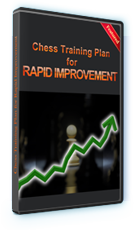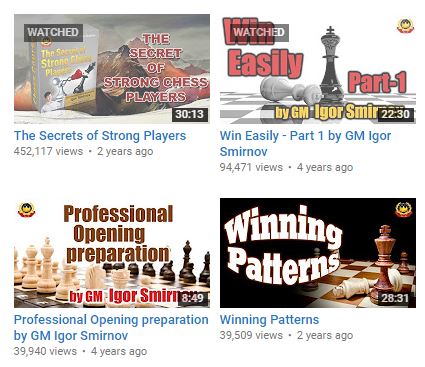Chess Strategy : Power of Pawn Storm 1
A PAWN STORM is a chess strategy in which several pawns are moved in rapid succession towards the opponent’s defenses. A pawn storm usually involves adjacent pawns on any one side of the board (king side or queen side).

Of course, it’s a true fact! Every chess player should continuously improve and expand his opening repertoire, if he wants to have steady progress. Such changes are required especially when you reach a HIGHER LEVEL.
One of the common reasons for STAGNATION of talented players is that they are reluctant to change their opening repertoiresas their playing strength increases.
For years, they often stick to the openings first learned in their youth, neglecting the fact that the opening gradually increases in importance the higher you get in the rankings. Instead of this approach, they should accept the challenge and begin the necessary rebuilding of their opening repertoire.

Yes, it demands investing a significant amount of time. But it’s the way to keep improving in the long run and to compete successfully at the NEW LEVEL. Chess is a complex, demanding game. There is NO shortcut for reaching a high-class standard.
Now, let’s look at a REAL story:-
Aleksandar Indjic (age19) is a very talented young Grand Master and the big hope of Serbian chess. In his career, he has already achieved many remarkable results. His FIDE rating graph kept constantly rising and currently he is at around 2550. On the way to reaching such a high level, he got a lot of points by winning many games with Benoni Openings as Black.

Among his victims were not only weak players but a few quite respectable names as well. But it was a time when he was not treated with the highest respect by his opponents (nowadays they do).Doubtlessly, GM Indjic understands and feels Benoni opening perfectly.
For years, his main coach was legendary Yugoslavian GM Drasko Velimirovic, who played this opening all the way through his rich chess career. He enjoys the reputation of being one of the greatest Benoni practitioners ever.

Benoni Defense
So, what’s the problem? Playing Benoni and similar openings against a player of lower strength is usually a good and promising choice. But using this against players over 2500 is a pretty risky adventure.
It could be suitable against strong opposition in individual games, as a surprise weapon, but it is hardly solid enough to be the basis of a HIGH-LEVEL opening repertoire:the general opinion is that such openings are simply not tenable at the highest level.
I believe young GM Indjic has already understood this after experiencing a few painful defeats recently. The latest one, at the Najdorf memorial in Warszawa this summer, came when he choose to risk his favourite opening against superb Polish GM Krasenkow. Now, it’s probably time to evolve YOUR repertoire.
GAME-1
Krasenkow,M (2623) – Indjic,A (2542)
Najdorf Mem Open A 2014 Warsaw POL (7.10), 18.07.2014
You can also find these games in PGN format here: LINK
1.d4 Nf6 2.c4 c5 3.d5.It was not difficult for Krasenkow to guess Black’s opening choice. And, of course, he was well prepared. 3…e6 4.Nc3 exd5 5.cxd5 d6 6.e4 g6

White’s turn
Indjic seems to be very confident and fearless with his Benoni. This move order allows White to play the unpleasant Taimanov Variation, with a quick f-pawn advance and Bb5+. In spite of being given this opportunity, GM Krasenkow opts for another, quieter positional approach that has been pretty popular of late. This is the so-called Modern Classic Variation –and is not easy to meet, either.
7.h3! The key move! With an early h3, White prevents Black’s favourite “freeing” idea of …Bg4. The exchanging of light-squared bishops favours Black, having in mind his space inferiority.
7…Bg7 8.Nf3 a6 9.a4 Nbd7 10.Bd3 Nh5 Delaying castling is an interesting attempt to respond to White’s h3, Nf3 and Bd3 set-up. The main point of Black’s play is to initiate immediate king side play. This strategy was successfully applied in a few games by GM Radoslaw Wojtaszek.
11.Bg5 White’s main choice and a very sensible attempt to thwart Black’s plans. White is also the side which doesn’t hurry to castle,avoiding the line 11.0–0 Ne5 12.Nxe5 { or12.Be2 Nxf3+ 13.Bxf3 Qh4!

The main point of not having castled is to exploit the half-open g-file after 14.Bh5 gh5}
12…Bxe5 13.f4 Bd4+ 14.Kh2 Qh4!? 15.Qf3 Nf6 16.Ne2 Ng4+ 17.Kh1 Nf2+ 18.Kh2 Ng4+ 19.Kh1 Nf2+ 20.Kh2 ½–½ (20) Sermier, G (2428)-Kovacevic, A (2598) Aix-les-Bains 2011.
11…Bf6 12.Bh6!

White h6-bishop prevents Black from castling
More active and challenging than 12.Be3 Ne5 13.Be2 Nxf3+ 14.Bxf3 Ng7
12…Ne5 Black continues his usual active plan, not wanting to enter the playable but somewhat inferior position in case of 12…Bg7 13.Bxg7 Nxg7 14.Qd2 0–0 15.0–0 b6 16.Rab1 f6 17.b4² ½–½ (45) Van Wely, L (2730)-Smith, B (2550) Chicago 2009. An interesting line that leads to a highly unbalanced position is 12…g5!? with the simple strategy…Rg8–g6 13.e5!? dxe5 14.0–0 Nf4 15.Ne4 According to my sources, this position is not tested in practice yet.
13.Nxe5 More direct than 13.Be2 Nxf3+ 14.Bxf3 Ng713…Bxe5 14.Qd2 Precise move order.14.0–0 Qh4! is rather dangerous for White. For example, 15.Qd2 Bxh3 16.gxh3 Qxh3 17.f3 g5! followed by …Bd4+14…Ng7 The most logical move. As alternatives, GM Ward suggests 14…Rg8, intending to meet 15.0–0?! with 15…g5, or 14…Bd7 retaining the option of …Rg8 and …g5. But it’s much easier to suggest such an adventurous idea than to play it in an actual game.
15.0–0 0–0 16.f4!

16.f4 starts White’s pawn assault!
The strong novelty that casts doubt on Black’s whole conception. Two examples from previous practice where Black achieved quite solid positions are:
- 16.Ne2 f5 17.exf5 gxf5 18.Bg5 Bf6 19.Bxf6 Qxf6 20.Nf4 Qd4 0–1 (44) Szromba, K (2118)-Wojtaszek, R (2449) Laczna 2002.
- 16.Rae1 f5 17.exf5 Bxf5 18.Ne4 Bxe4 19.Rxe4 Qf6 20.Bg5 Qf7 ½–½ (73) Rogozenco, D (2541)-Valeanu ,E (2440) Eforie Nord 2008.
16…Bd4+ 17.Kh2 Bd7 Black missed his last chance to play the liberating 17…f5 move. But he wouldn’t have solved his problems if he had played this thematic move either.
For example: 17…f5 18.Rae1 Re8 (after 18…fxe4 19.Nxe4 Black can’t play 19…Nf5; he is behind in development and his position has many strategic weaknesses) 19.exf5 Nxf5 (19…Bxf5 20.Bxg7 Bxg7 21.Bxf5 gxf5 22.Re6±) 20.Bg5 Qd7 21.Bxf5 gxf5 22.Rxe8+ Qxe8 23.Re1 Qg6 24.Re7± In the above lines, one should notice the important restricting role of White’s dark-squared bishop.
18.Ne2! This puts an end to Black’s main idea …f5. The most vital Black piece in the Benoni, the fianchettoed dark-squared bishop, happens to be a problem – having only the f6 square available.
18…Bf6 19.g4

Black’s turn
…and even that square is not the safest. Very likely, Indjic didn’t feel comfortable at this point,despite that this was “his kind of position”. Indeed, lacking the space and without the liberating …f5, it is already very difficult for Black to find an adequate answer.
The inevitable pawn storm in the centre and on the king side is supported by all White’s pieces. I can only imagine the grim face and the disapproving nodding of Indjic’s coach, the late GM Velimirovic, if he had been behind his talented student.
19…Qb6 Short-term activity trying to keep the bishop on the a1-h8 diagonal, avoiding either 19…Re8 20.g5 Be7±; or 19…b5 20.e5 dxe5 21.g5 Be7 22.fxe5±
20.g5 Qxb2 21.Qxb2 Instead of opting for this risk-free advantageous line by exchanging queens, it might be better to continue with21.Bc2! After the more or less forcing moves 21…Qxa1 22.Rxa1 Bxa1 23.Qd1 Bb2 24.Qb1 Bd4 25.Qb6± It’s hard to believe that Black can hold on to this position.
21…Bxb2 22.Rab1 Ba3 Misplacing the bishop was unavoidable.23.Rxb7 Rfd8 24.f5 White continues with energetic play. But giving up control of the e5 square is a responsible decision.24.Ng3 was an option.
24…Bb4?! Wasting precious time. Black should get rid of Rb7 as fast as possible. He missed the opportunity to offer a pawn sacrifice. 24…Rab8! With the strategy of relocating his bishop to the excellent e5 square in case of 25.Bxa6 Bb2
25.Nf4 25.Nd4!? Was also good. 25…Rab8

White’s turn
The line 25…gxf5 26.Bxg7 Kxg7 27.Ne6+ fxe6 28.dxe6± is much better for White.26.Ne6! This comes out of the blue –storming the barricade by sacrificing the knight. White wants to destroy Black’s defence with the brute force of his advanced united pawn mass. 26.Ra7 Ra8=
26…fxe6 The sacrifice must be accepted. Unsatisfactory is 26…Rxb7 27.Nxd8 Rb8 28.Nc6 Re8 29.f6 Bxc6 (29…Nh5 30.Ne7+ Kh8 31.Be2+–) 30.dxc6 Ne6 31.Bxa6±
27.Rxb8The following computer line demonstrates how complex the position is: 27.Rxd7 Rxd7 28.dxe6 c4 29.exd7 cxd3 30.f6 Nf5 31.exf5 Kf7 32.Rb1 d2 33.Rxb4 d1Q 34.Rxb8 Qd2+=
27…Rxb8 28.dxe6

Black’s turn
28…Bxa4?It is very difficult to criticize this “human move”, with the simple strategy to take the pawn and play 29…Bb5 next. But there is no time for that.
The correct defence was 28…Bc6! creating the possibility to react with …d5, neutralizing the effect of White’s killing Bc4. After 29.e7 (weaker is 29.Bc4 gxf5 30.e7+ d5 31.exd5 Bd7 32.d6+ Kh8 33.Bxg7+ Kxg7) 29…gxf5 30.exf5 Bc3 (30…Be8 31.g6 hxg6 32.fxg6 Bc6 33.Bc4+ d5 34.Rf7 Bc3 35.Bxa6=) 31.Bc4+ d5 32.f6 Be5+ 33.Kg1 Bd4+ 34.Kh2 Be5+ Black is saved by perpetual check.
29.Bc4 Bb5? Another cooperative move. The position is difficult but Black could have had practical chances after 29…gxf5! 30.e7+ d5 – the idea is to sacrifice both pawns in order to control the a3-f8 diagonal. 31.Bxd5+ Kh8 32.Rxf5 (32.exf5 c4 33.f6 Nh5 34.Bxc4 also favours White) 32…c4 33.Rf7 Nh5
30.Bd5!

White is using a power of his connected pawns!
This seals Black’s fate! Black didn’t succeed in exchanging or neutralizing White’s STRONGEST attacking piece, the light-squared bishop. On the other side, his two bishops are excluded from the main battlefield. And what about the rook on f1?! Who cares about material when one has two united passed pawns on the 6th rank supported by a bishop’s pair! There is no way to hold Black’s position.
30…gxf5 or 30…Bxf1 31.e7+ Kh8 32.f6 Nf5 33.exf5+–
31.e7+ Kh8 32.Bxg7+ Another spectacular winning line was 32.exf5 Bxf1 33.f6 Nf5 34.Bg7+ Nxg7 35.f7+–32…Kxg7 33.exf5 Be8 34.f6+ Kg6 35.f7 Bxf7 36.Bxf7+ Kxg5 37.e8Q Rxe8 38.Bxe8 c4 39.Bc6 c3 40.Be4 h5 41.Rf5+ Kh6 42.Kg3 a5 43.Rf7 Kg5 44.h4+ Kh6 45.Rh7#
1–0
This is a near-perfect example of excellent “human” preparation. To avoid becoming an easy target against “laptop-armed chess killers”, you must be willing to play different openings.
But beware! Avoid the scenario where, in order to surprise your opponent, you find yourself in a kind of an unfamiliar position (territory). Your every choice must be based on solid knowledge and preparation.
If you act to the contrary, it may happen that your “surprise weapon” boomerangs back to you, with your opponent smiling on top of it! Krasenkow’s approach to the game deserves the highest assessment. After launching the prepared novelty, with some energetic play he crowned this beautiful game with a surprising sacrifice. The game is instructive from various aspects.
Therefore, don’t underestimate the power of a pawn storm–a brutal and dangerous attacking weapon.

Let’s see another example in which the pawn steamroller dominated. The common features in all the given examples are highly imaginative and courageous play.
As a RULE: to gain a dangerous pawn mass, it is necessary to sacrifice material, usually a piece or exchange.
GAME-2
Bologan,Viktor (2687) – Mchedlishvili,Mikheil
EU-ch 13th Plovdiv (9), 29.03.2012
You can also find these games in PGN format here: LINK
1.e4 c6 2.Nf3 d5 3.Nc3 Nf6 4.e5 Ne4 5.h3 e6 6.d4 c5 7.Bd3 Nxc3 8.bxc3 c4 9.Be2 Be7 10.h4 Nc6 11.h5 h6 12.g3 Qa5 13.Qd2 Bd7 14.Nh4 0–0–0 15.a4 Rdg8 16.Bg4 Bg5 17.f4 Be7 18.Kf2 g5 19.hxg6 fxg6 20.Nf3 Qd8 21.Qe2 Qf8 22.Kg2 Nd8 23.a5 Nf7 24.Rf1 Qg7 25.Nd2 h5 26.Bf3 g5

White’s turn
Critical moment! The tension in the game has reached its CLIMAX. Black is threatening to open the position of White’s king with an irresistible attack. TIME is a crucial factor and, to be in the game, White must strike FIRST.
27.Nxc4! g4? The decisive mistake! Black underestimates White’s attacking potential. Being greedy, he lost the sense of danger. The position demands opening the king side with 27…gxf4 28.Bxf4 Bg5 28.Bxd5! exd5

White’s turn
29.Nb6+!! With double piece sacrifices, White opens lines towards Black’s king. In spite of reduced attacking resources, he is developing an overwhelming attack. Notice that the position of his king is much safer than a couple of moves ago.
29…axb6 30.axb6 Kd8 Black can’t save the game either after 30…Kb8 31.e6+–; or 30…Bd6 31.Ra8+ Bb8 32.f5! with the idea e6 and Bf4
31.Ra8+ Bc8 32.Qb5! Despite being two pieces down, White is completely winning. Black’s minor pieces are tied up, while his heavy pieces are far from the main battle area. In addition, faced with these direct threats, Black lacks any counter-play. 32…Nd6 33.Qxd5 Qf7 34.Qc5! Bf8 35.f5!

Black’s turn
There is no reason to hurry with 35.ed6. White wants control of the light squares, too, and his pawns are simply too strong.
35…Qd7 36.e6 A more entertaining win than the equally pretty straightforward geometrical approach of 36.exd6 Bxd6 37.Rxc8+ Qxc8 38.Qxd6+ Qd7 39.Bg5+ Rxg5 40.Qf6++–
36…Qc6+ 37.Qxc6 bxc6 38.f6! Rh7 39.f7 Rg6 40.Ba3 Rxe6 41.Bxd6
1–0



